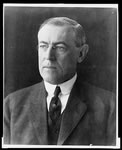|

|
The Debate in the United States over the League of Nations: League of Nations Basics
Introduction
American foreign policy continues to resonate with the issues surrounding the debate over U.S. entry into the League of Nations-collective security versus national sovereignty, idealism versus pragmatism, the responsibilities of powerful nations, the use of force to accomplish idealistic goals, the idea of America. Understanding the debate over the League and the consequences of its ultimate failure provides insight into international affairs in the years since the end of the Great War and beyond.
In this lesson, students read the words and listen to the voices of some central participants in the debate over the League of Nations.
Note: This lesson may be taught either as a stand-alone lesson or as
part of the curriculum unit, The
Debate in the United States Over the League of Nations. This curriculum
unit may serve as a sequel to the complementary EDSITEment lesson U.S.
Entry into World War I: A Documentary Chronology.
Guiding Question:
What was Woodrow Wilson's role in and vision for peace and the League of Nations after World War I?
Learning Objectives
After completing the lessons in this unit, students will be able to:
- Describe Wilson's concepts for peace and the League of Nations and efforts to foster American support for it.
Share with the class the card The
League of Nations: A Pictorial Study on the PBS website Woodrow
Wilson, a link from the EDSITEment resource American
Memory.
Guiding Discussion Questions:
- Why is Wilson pictured at the center of the card?
- Look at the text surrounding Wilson's image. What is its significance?
- Why is the Fourteenth Point printed at the bottom of the card?
XIV. A general association of nations must be formed under specific covenants for the purpose of affording mutual guarantees of political independence and territorial integrity to great and small states alike.
- The League of Nations printed this card. How might the card's contents and design serve the interests of the League?
Review President Wilson's Fourteen Points (found within the text of Wilson's January 8, 1918, address to a joint session of Congress) on the EDSITEment resource Great War Primary Documents Archive.
Guiding Discussion Questions:
- Which points were about specific territorial issues in Europe and elsewhere?
- Review points 1-5 and 14:
I. Open treaties
II. Freedom of navigation upon the seas
III. Removal of economic barriers
IV. Reduction of arms
V. Free, open-minded, and absolutely impartial adjustment of all colonial claims
XIV. (See above.)
- Which, if any, would be of little benefit/great benefit to powerful nations like the U.S.?
- Which, if any, would be of little benefit/great benefit to weaker nations?
- Which, if any, would likely be regarded as taking away some of the power of the U.S. as a sovereign nation?
Now share with students The Covenant and Members of the League of Nations on the EDSITEment-reviewed website Links to the Past.
Guiding Discussion Questions:
- Which nations were not members of the League?
- What were the basic tenets of the Covenant? (If desired, look at the complete text of the Covenant of the League of Nations available on the PBS website Woodrow Wilson, a link from the EDSITEment resource American Memory.)
- Look at the introduction to the Covenant. Compare it to the Fourteenth Point.
THE HIGH CONTRACTING PARTIES, In order to promote international co-operation and to achieve international peace and security by the acceptance of obligations not to resort to war, by the prescription of open, just and honorable relations between nations, by the firm establishment of the understandings of international law as the actual rule of conduct among Governments, and by the maintenance of justice and a scrupulous respect for all treaty obligations in the dealings of organized peoples with one another, agree to this Covenant of the League of Nations.
Students wanting more detail about the origins and History of the League of Nations can read this brief essay on From Revolution to Reconstruction, a link from the EDSITEment-reviewed website American Studies at the University of Virginia.
Assessment
In writing or through oral response to questions, students should be able to describe President Wilson's role in creating the League of Nations. They should understand the basic issues covered in Wilson's Fourteen points, and compare those with the tenets in the Covenant of the League of Nations.
Selected EDSITEment Websites
Standards Alignment
View your state’s standards
|





